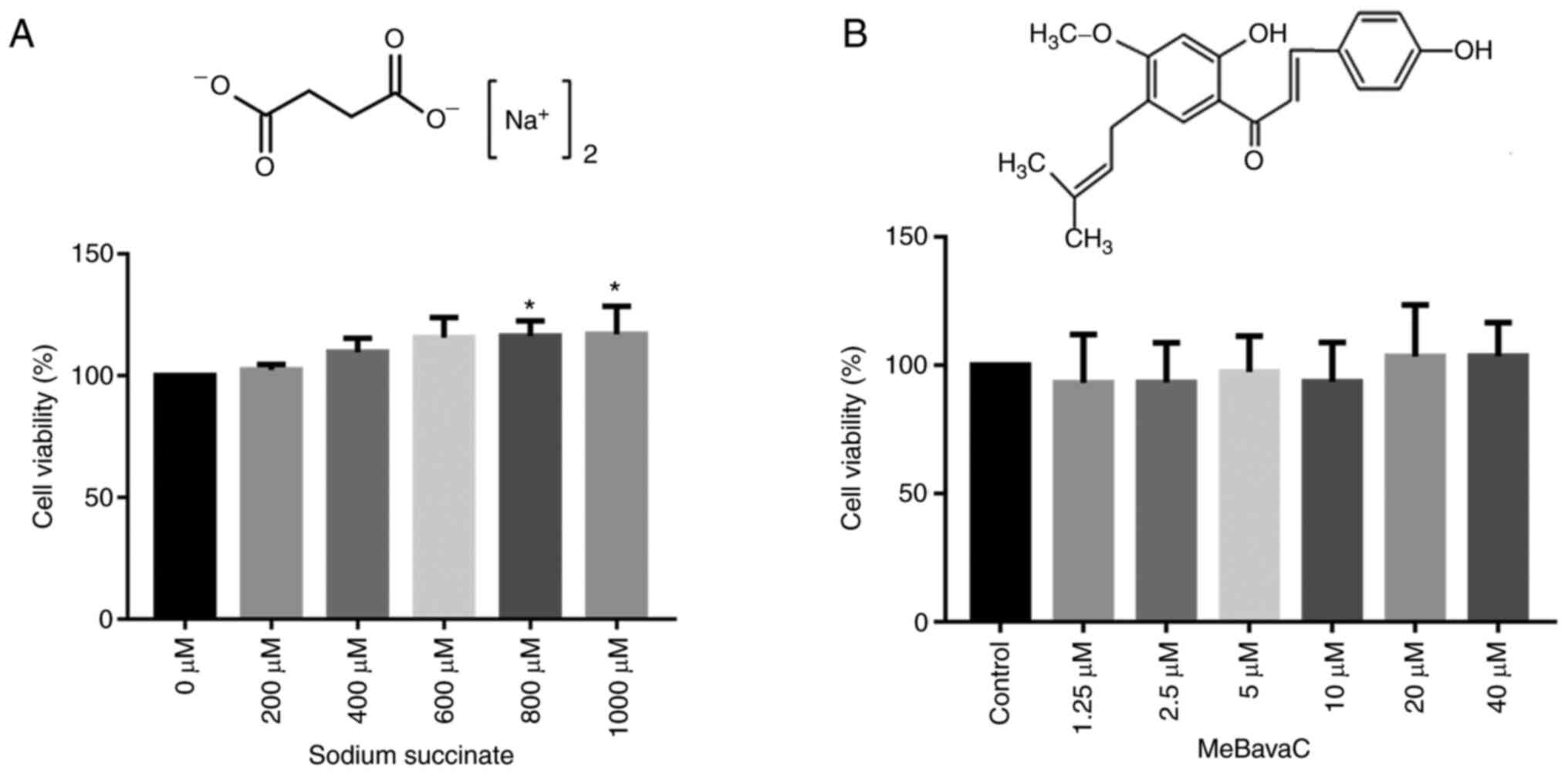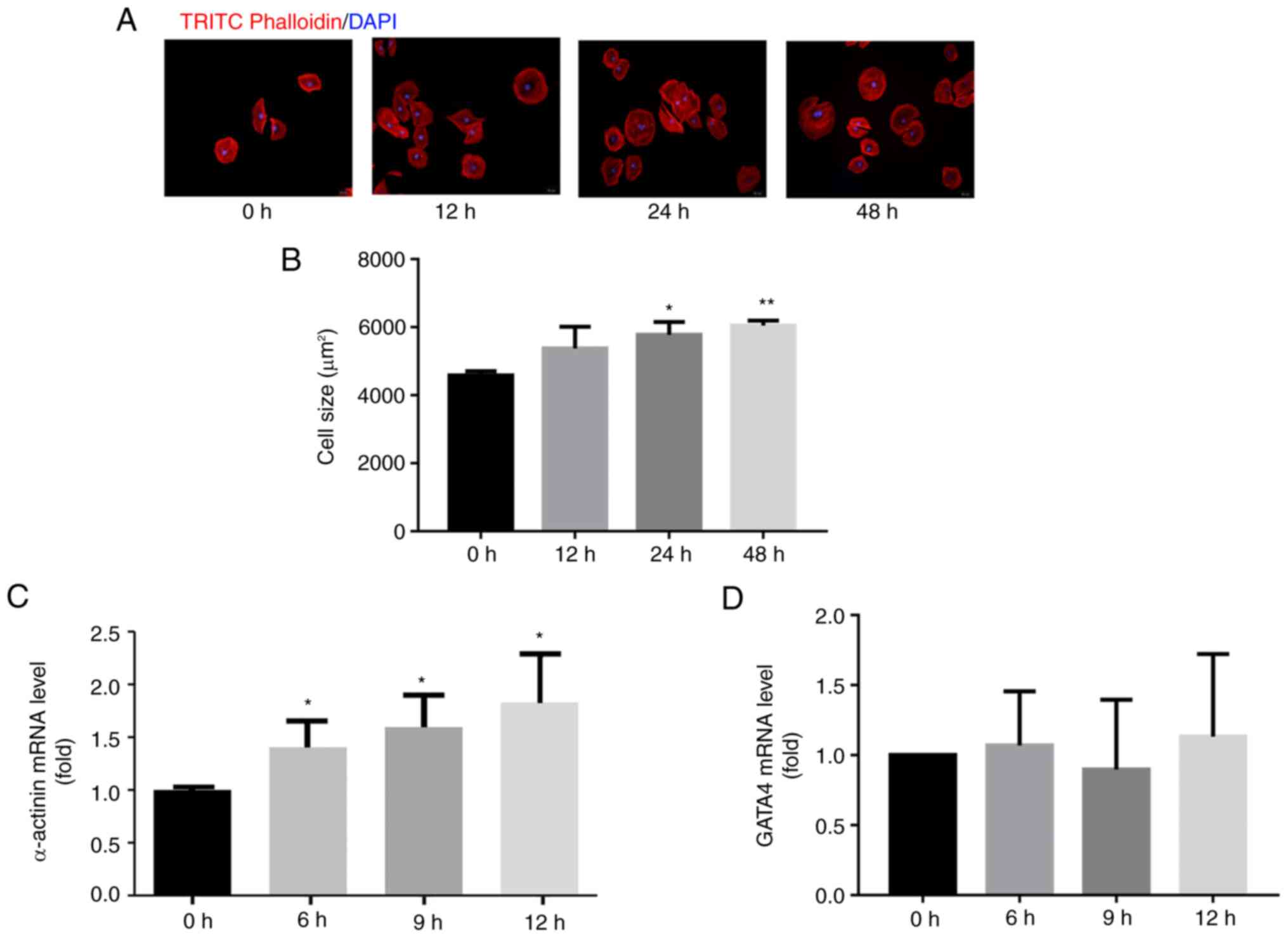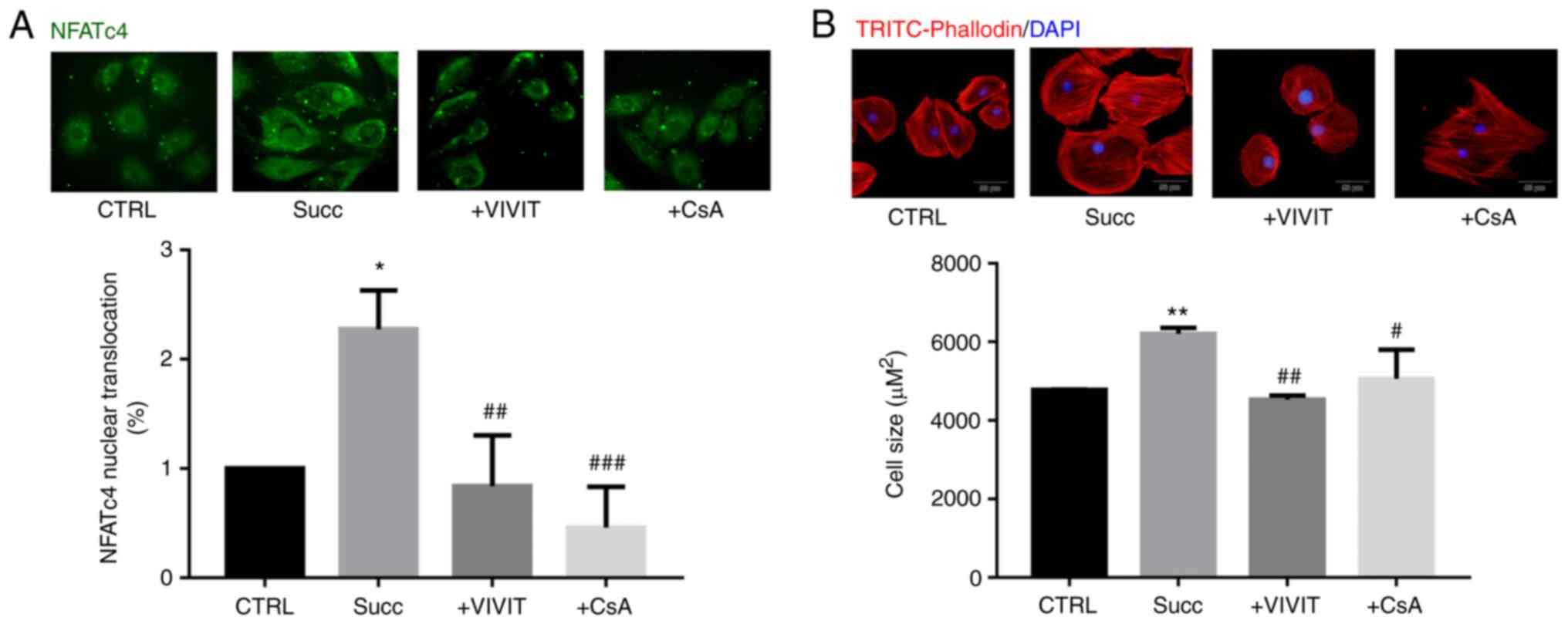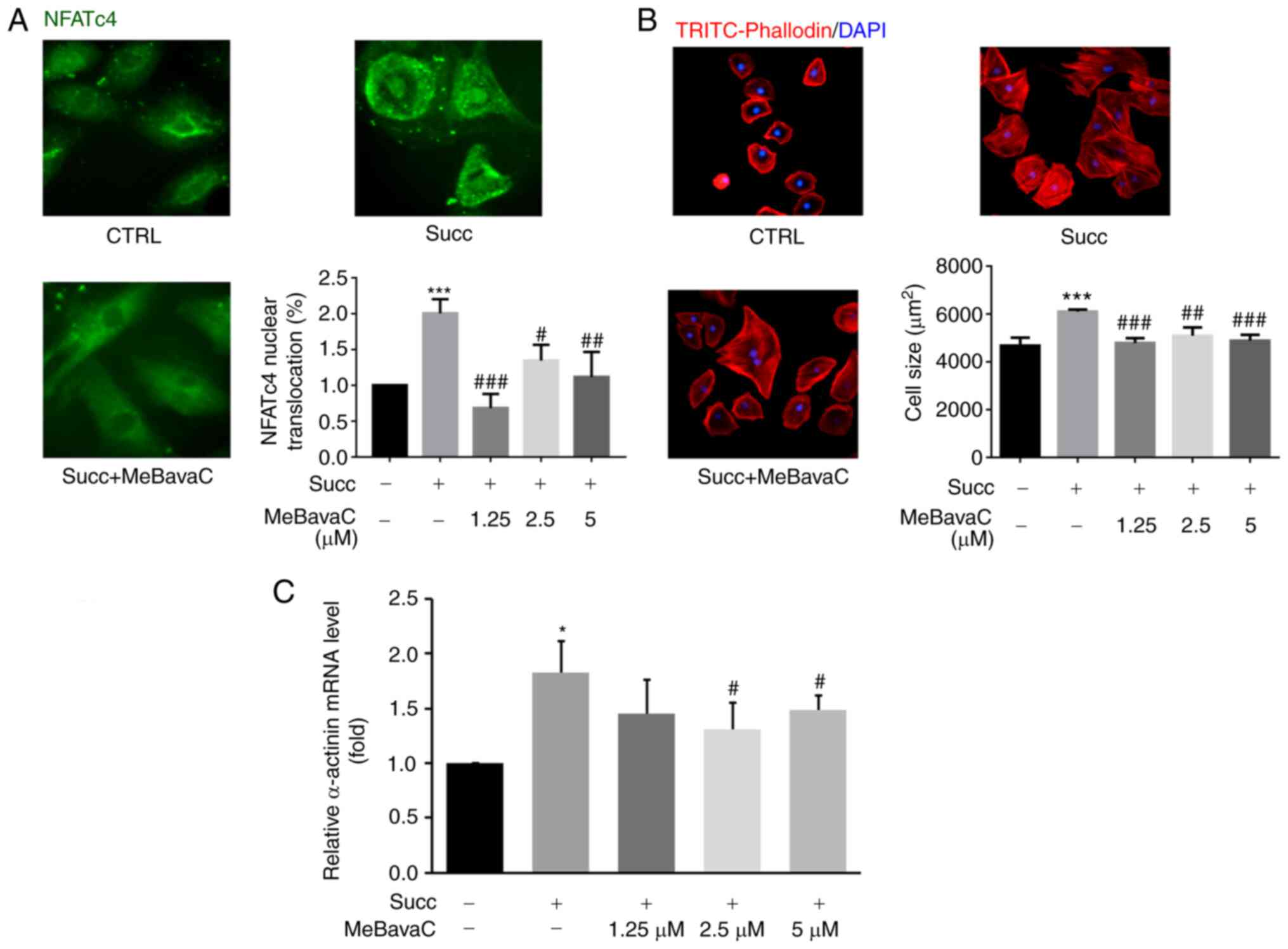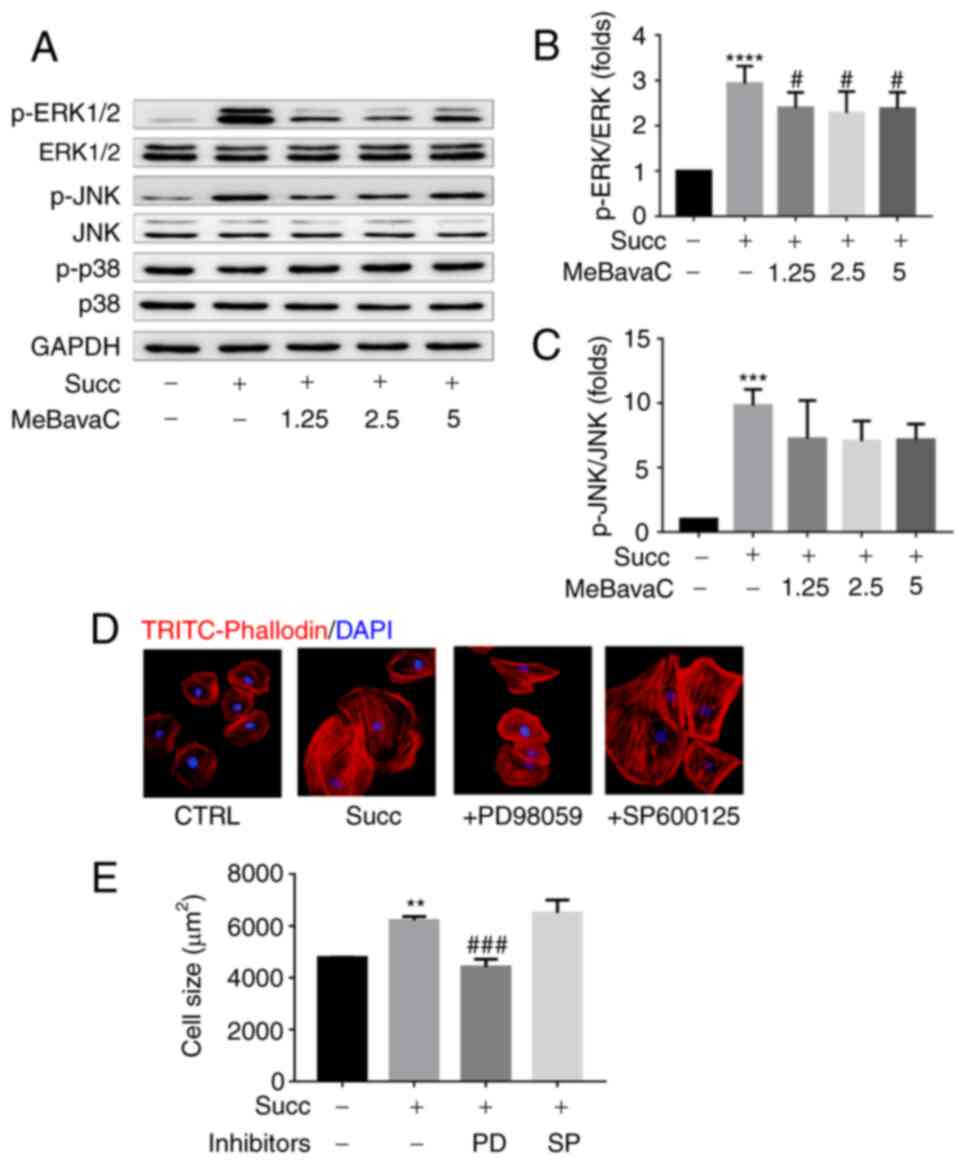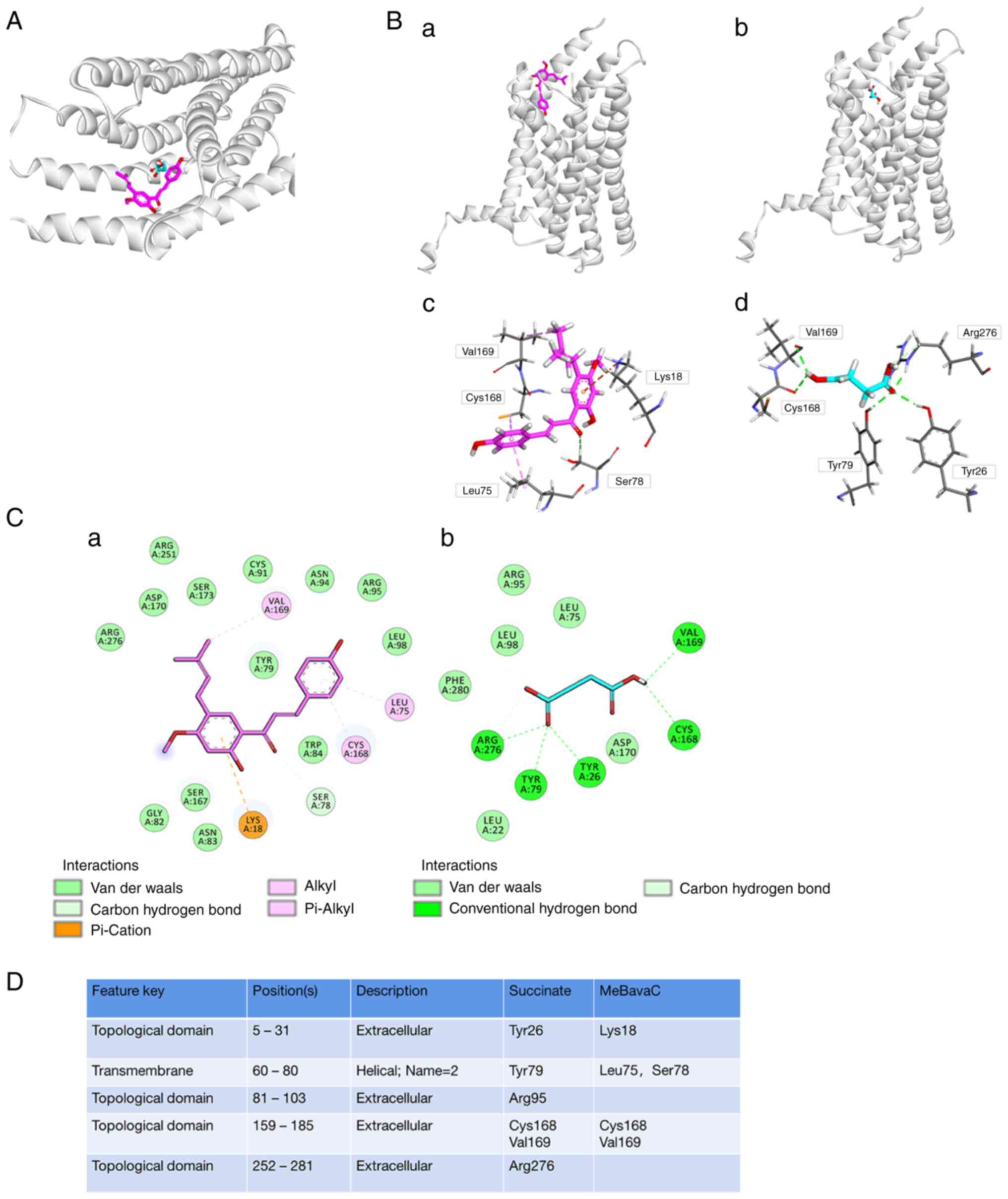|
1
|
Gould KL, Lipscomb K, Hamilton GW and
Kennedy JW: Left ventricular hypertrophy in coronary artery
disease. A cardiomyopathy syndrome following myocardial infarction.
Am J Med. 55:595–601. 1973.PubMed/NCBI View Article : Google Scholar
|
|
2
|
Momiyama Y, Suzuki Y, Ohsuzu F, Atsumi Y,
Matsuoka K and Kimura M: Left ventricular hypertrophy and diastolic
dysfunction in mitochondrial diabetes. Diabetes Care. 24:604–605.
2001.PubMed/NCBI View Article : Google Scholar
|
|
3
|
De Simone G, Devereux RB, Roman MJ,
Alderman MH and Laragh JH: Relation of obesity and gender to left
ventricular hypertrophy in normotensive and hypertensive adults.
Hypertension. 23:600–606. 1994.PubMed/NCBI View Article : Google Scholar
|
|
4
|
Li H, He C, Feng J, Zhang Y, Tang Q, Bian
Z, Bai X, Zhou H, Jiang H, Heximer SP, et al: Regulator of G
protein signaling 5 protects against cardiac hypertrophy and
fibrosis during biomechanical stress of pressure overload. Proc
Natl Acad Sci USA. 107:13818–13823. 1994.PubMed/NCBI View Article : Google Scholar
|
|
5
|
Cibi DM, Bi-Lin KW, Shekeran SG,
Sandireddy R, Tee N, Singh A, Wu Y, Srinivasan DK, Kovalik JP,
Ghosh S, et al: Prdm16 deficiency leads to age-dependent cardiac
hypertrophy, adverse remodeling, mitochondrial dysfunction, and
heart failure. Cell Rep. 33(108288)2020.PubMed/NCBI View Article : Google Scholar
|
|
6
|
Ritterhoff J, Young S, Villet O, Shao D,
Neto FC, Bettcher LF, Hsu YA, Kolwicz SC Jr, Raftery D and Tian R:
Metabolic remodeling promotes cardiac hypertrophy by directing
glucose to aspartate biosynthesis. Circ Res. 126:182–196.
2020.PubMed/NCBI View Article : Google Scholar
|
|
7
|
Zhang T and Brown JH: Role of
Ca2+/calmodulin-dependent protein kinase II in cardiac
hypertrophy and heart failure. Cardiovasc Res. 63:476–486.
2004.PubMed/NCBI View Article : Google Scholar
|
|
8
|
Yang L, Cao J, Ma J, Li M and Mu Y:
Differences in the microcirculation disturbance in the right and
left ventricles of neonatal rats with hypoxic pulmonary
hypertension. Microvasc Res. 135(104129)2021.PubMed/NCBI View Article : Google Scholar
|
|
9
|
Liu HB, Yang BF and Dong DL: Calcineurin
and electrical remodeling in pathologic cardiac hypertrophy. Trends
Cardiovasc Med. 20:148–153. 2010.PubMed/NCBI View Article : Google Scholar
|
|
10
|
Molkentin JD: Calcineurin and beyond:
Cardiac hypertrophic signaling. Circ Res. 87:731–738.
2000.PubMed/NCBI View Article : Google Scholar
|
|
11
|
Crabtree GR: Generic signals and specific
outcomes: Signaling through Ca2+, calcineurin, and
NF-AT. Cell. 96:611–614. 1999.PubMed/NCBI View Article : Google Scholar
|
|
12
|
Wilkins BJ, Dai YS, Bueno OF, Parsons SA,
Xu J, Plank DM, Jones F, Kimball TR and Molkentin JD:
Calcineurin/NFAT coupling participates in pathological, but not
physiological, cardiac hypertrophy. Circ Res. 94:110–118.
2004.PubMed/NCBI View Article : Google Scholar
|
|
13
|
Mathew S, Mascareno E and Siddiqui MA: A
ternary complex of transcription factors, Nished and NFATc4, and
co-activator p300 bound to an intronic sequence, intronic
regulatory element, is pivotal for the up-regulation of myosin
light chain-2v gene in cardiac hypertrophy. J Biol Chem.
279:41018–41027. 2004.PubMed/NCBI View Article : Google Scholar
|
|
14
|
Van Rooij E, Doevendans PA, de Theije CC,
Babiker FA, Molkentin JD and de Windt LJ: Requirement of nuclear
factor of activated T-cells in calcineurin-mediated cardiomyocyte
hypertrophy. J Biol Chem. 277:48617–48626. 2002.PubMed/NCBI View Article : Google Scholar
|
|
15
|
Molkentin JD: Calcineurin-NFAT signaling
regulates the cardiac hypertrophic response in coordination with
the MAPKs. Cardiovasc Res. 63:467–475. 2004.PubMed/NCBI View Article : Google Scholar
|
|
16
|
Pin F, Barreto R, Couch ME, Bonetto A and
O'Connell TM: Cachexia induced by cancer and chemotherapy yield
distinct perturbations to energy metabolism. J Cachexia Sarcopenia
Muscle. 10:140–154. 2019.PubMed/NCBI View Article : Google Scholar
|
|
17
|
Lehwald N, Tao GZ, Jang KY, Papandreou I,
Liu B, Liu B, Pysz MA, Willmann JK, Knoefel WT, Denko NC and
Sylvester KG: β-Catenin regulates hepatic mitochondrial function
and energy balance in mice. Gastroenterology. 143:754–764.
2012.PubMed/NCBI View Article : Google Scholar
|
|
18
|
Björntorp P: The oxidation of fatty acids
combined with albumin by isolated rat liver mitochondria. J Biol
Chem. 241:1537–1543. 1966.PubMed/NCBI
|
|
19
|
Sadagopan N, Li W, Roberds SL, Major T,
Preston GM, Yu Y and Tones MA: Circulating succinate is elevated in
rodent models of hypertension and metabolic disease. Am J
Hypertens. 20:209–1215. 2007.PubMed/NCBI View Article : Google Scholar
|
|
20
|
Kohlhauer M, Dawkins S, Costa ASH, Lee R,
Young T, Pell VR, Choudhury RP, Banning AP and Kharbanda RK: Oxford
Acute Myocardial Infarction (OxAMI) Study et al. Metabolomic
profiling in acute ST-segment-elevation myocardial infarction
identifies succinate as an early marker of human
ischemia-reperfusion injury. J Am Heart Assoc.
7(e007546)2018.PubMed/NCBI View Article : Google Scholar
|
|
21
|
de Castro Fonseca M, Aguiar CJ, da Rocha
Franco JA, Gingold RN and Leite MF: GPR91: Expanding the frontiers
of Krebs cycle intermediates. Cell Commun Signal.
14(3)2016.PubMed/NCBI View Article : Google Scholar
|
|
22
|
Li X, Xie L, Qu X, Zhao B, Fu W, Wu B and
Wu J: GPR91, a critical signaling mechanism in modulating
pathophysiologic processes in chronic illnesses. FASEB J.
34:13091–13105. 2020.PubMed/NCBI View Article : Google Scholar
|
|
23
|
Yang L, Yu D, Mo R, Zhang J, Hua H, Hu L,
Feng Y, Wang S, Zhang WY, Yin N and Mo XM: The succinate receptor
GPR91 is involved in pressure overload-induced ventricular
hypertrophy. PLoS One. 11(e0147597)2016.PubMed/NCBI View Article : Google Scholar
|
|
24
|
Aguiar CJ, Rocha-Franco JA, Sousa PA,
Santos AK, Ladeira M, Rocha-Resende C, Ladeira LO, Resende RR,
Botoni FA, Melo MB, et al: Succinate causes pathological
cardiomyocyte hypertrophy through GPR91 activation. Cell Commun
Signal. 12(78)2014.PubMed/NCBI View Article : Google Scholar
|
|
25
|
Chinese Pharmacopoeia Commission, 2020.
Psoraleae. Fructus. In: Pharmacopoeia of the People's Republic of
China. China Medical Science Press, Beijing. pp 195.
|
|
26
|
Zhou YT, Zhu L, Yuan Y, Ling S and Xu JW:
Effects and mechanisms of five psoralea prenylflavonoids on
aging-related diseases. Oxid Med Cell Longev.
2020(2128513)2020.PubMed/NCBI View Article : Google Scholar
|
|
27
|
Yan C, Wu Y, Weng Z, Gao Q, Yang G, Chen
Z, Cai B and Li W: Development of an HPLC method for absolute
quantification and QAMS of flavonoids components in Psoralea
corylifolia L. J Anal Methods Chem. 2015(792637)2015.PubMed/NCBI View Article : Google Scholar
|
|
28
|
Kim DW, Seo KH, Curtis-Long MJ, Oh KY, Oh
JW, Cho JK, Lee KH and Park KH: Phenolic phytochemical displaying
SARS-CoV papain-like protease inhibition from the seeds of Psoralea
corylifolia. J Enzyme Inhib Med Chem. 29:59–63. 2014.PubMed/NCBI View Article : Google Scholar
|
|
29
|
Cooper JA: Effects of cytochalasin and
phalloidin on actin. J Cell Biol. 105:1473–1478. 1987.PubMed/NCBI View Article : Google Scholar
|
|
30
|
Jia G, Liang C, Li W and Dai H: MiR-410-3p
facilitates angiotensin II-induced cardiac hypertrophy by targeting
Smad7. Bioengineered. 13:119–127. 2022.PubMed/NCBI View Article : Google Scholar
|
|
31
|
Sugawara Y, Kamioka H, Honjo T, Tezuka K
and Takano-Yamamoto T: Three-dimensional reconstruction of chick
calvarial osteocytes and their cell processes using confocal
microscopy. Bone. 36:877–883. 2005.PubMed/NCBI View Article : Google Scholar
|
|
32
|
Livak KJ and Schmittgen TD: Analysis of
relative gene expression data using real-time quantitative PCR and
the 2(Delta Delta C(T)) method. Methods. 25:402–408.
2001.PubMed/NCBI View Article : Google Scholar
|
|
33
|
Burley SK, Berman HM, Kleywegt GJ, Markley
JL, Nakamura H and Velankar S: Protein data bank (PDB): The single
global macromolecular structure archive. Methods Mol Biol.
1607:627–641. 2017.PubMed/NCBI View Article : Google Scholar
|
|
34
|
Haffke M, Fehlmann D, Rummel G, Boivineau
J, Duckely M, Gommermann N, Cotesta S, Sirockin F, Freuler F,
Littlewood-Evans A, et al: Structural basis of species-selective
antagonist binding to the succinate receptor. Nature. 574:581–585.
2019.PubMed/NCBI View Article : Google Scholar
|
|
35
|
Trauelsen M, Ulven ER, Hjorth SA, Brvar M,
Monaco C, Frimurer TM and Schwartz TW: Receptor structure-based
discovery of non-metabolite agonists for the succinate receptor
GPR91. Mol Metab. 6:1585–1596. 2017.PubMed/NCBI View Article : Google Scholar
|
|
36
|
Tang X, Fuchs D, Tan S, Trauelsen M,
Schwartz TW, Wheelock CE, Li N and Haeggström JZ: Activation of
metabolite receptor GPR91 promotes platelet aggregation and
transcellular biosynthesis of leukotriene C4. J Thromb Haemost.
18:976–984. 2020.PubMed/NCBI View Article : Google Scholar
|
|
37
|
Bulló M, Papandreou C, García-Gavilán J,
Ruiz-Canela M, Li J, Guasch-Ferré M, Toledo E, Clish C, Corella D,
Estruch R, et al: Tricarboxylic acid cycle related-metabolites and
risk of atrial fibrillation and heart failure. Metabolism.
125(154915)2021.PubMed/NCBI View Article : Google Scholar
|
|
38
|
Du Z, Shen A, Huang Y, Su L, Lai W, Wang
P, Xie Z, Xie Z, Zeng Q, Ren H and Xu D: 1H-NMR-based metabolic
analysis of human serum reveals novel markers of myocardial energy
expenditure in heart failure patients. PLoS One.
9(e88102)2014.PubMed/NCBI View Article : Google Scholar
|
|
39
|
Yao H, Shi P, Zhang L, Fan X, Shao Q and
Cheng Y: Untargeted metabolic profiling reveals potential
biomarkers in myocardial infarction and its application. Mol
Biosyst. 6:1061–1070. 2010.PubMed/NCBI View Article : Google Scholar
|
|
40
|
Zhang J, Wang YT, Miller JH, Day MM,
Munger JC and Brookes PS: Accumulation of succinate in cardiac
ischemia primarily occurs via canonical Krebs cycle activity. Cell
Rep. 23:2617–2628. 2018.PubMed/NCBI View Article : Google Scholar
|
|
41
|
Galla S, Chakraborty S, Cheng X, Yeo JY,
Mell B, Chiu N, Wenceslau CF, Vijay-Kumar M and Joe B: Exposure to
amoxicillin in early life is associated with changes in gut
microbiota and reduction in blood pressure: Findings from a study
on rat dams and offspring. J Am Heart Assoc.
9(e014373)2020.PubMed/NCBI View Article : Google Scholar
|
|
42
|
Serena C, Ceperuelo-Mallafré V, Keiran N,
Queipo-Ortuño MI, Bernal R, Gomez-Huelgas R, Urpi-Sarda M, Sabater
M, Pérez-Brocal V, Andrés-Lacueva C, et al: Elevated circulating
levels of succinate in human obesity are linked to specific gut
microbiota. ISME J. 12:1642–1657. 2018.PubMed/NCBI View Article : Google Scholar
|
|
43
|
Yang L, Yu D, Fan HH, Feng Y, Hu L, Zhang
WY, Zhou K and Mo XM: Triggering the succinate receptor GPR91
enhances pressure overload-induced right ventricular hypertrophy.
Int J Clin Exp Pathol. 7:5415–5428. 2014.PubMed/NCBI
|
|
44
|
Littlewood-Evans A, Sarret S, Apfel V,
Loesle P, Dawson J, Zhang J, Muller A, Tigani B, Kneuer R, Patel S,
et al: GPR91 senses extracellular succinate released from
inflammatory macrophages and exacerbates rheumatoid arthritis. J
Exp Med. 213:1655–1662. 2016.PubMed/NCBI View Article : Google Scholar
|
|
45
|
Ko SH, Choi GE, Oh JY, Lee HJ, Kim JS,
Chae CW, Choi D and Han HJ: Succinate promotes stem cell migration
through the GPR91-dependent regulation of DRP1-mediated
mitochondrial fission. Sci Rep. 7(12582)2017.PubMed/NCBI View Article : Google Scholar
|
|
46
|
Trauelsen M, Hiron TK, Lin D, Petersen JE,
Breton B, Husted AS, Hjorth SA, Inoue A, Frimurer TM, Bouvier M, et
al: Extracellular succinate hyperpolarizes M2 macrophages through
SUCNR1/GPR91-mediated Gq signaling. Cell Rep.
35(109246)2021.PubMed/NCBI View Article : Google Scholar
|
|
47
|
Sundström L, Greasley PJ, Engberg S,
Wallander M and Ryberg E: Succinate receptor GPR91, a Gα(i) coupled
receptor that increases intracellular calcium concentrations
through PLCβ. FEBS Lett. 587:2399–2404. 2013.PubMed/NCBI View Article : Google Scholar
|
|
48
|
Pfeil EM, Brands J, Merten N, Vögtle T,
Vescovo M, Rick U, Albrecht IM, Heycke N, Kawakami K, Ono Y, et al:
Heterotrimeric G protein subunit Gαq is a master switch for
Gβγ-mediated calcium mobilization by Gi-coupled GPCRs. Mol Cell.
80:940–954.e6. 2020.PubMed/NCBI View Article : Google Scholar
|
|
49
|
Backs J, Backs T, Neef S, Kreusser MM,
Lehmann LH, Patrick DM, Grueter CE, Qi X, Richardson JA, Hill JA,
et al: The delta isoform of CaM kinase II is required for
pathological cardiac hypertrophy and remodeling after pressure
overload. Proc Natl Acad Sci USA. 106:2342–2347. 2009.PubMed/NCBI View Article : Google Scholar
|
|
50
|
Pieske B, Kretschmann B, Meyer M,
Holubarsch C, Weirich J, Posival H, Minami K, Just H and Hasenfuss
G: Alterations in intracellular calcium handling associated with
the inverse force-frequency relation in human dilated
cardiomyopathy. Circulation. 92:1169–1178. 1995.PubMed/NCBI View Article : Google Scholar
|
|
51
|
Prondzynski M, Lemoine MD, Zech AT,
Horváth A, Di Mauro V, Koivumäki JT, Kresin N, Busch J, Krause T,
Krämer E, et al: Disease modeling of a mutation in α-actinin 2
guides clinical therapy in hypertrophic cardiomyopathy. EMBO Mol
Med. 11(e11115)2019.PubMed/NCBI View Article : Google Scholar
|
|
52
|
Sheng JJ, Feng HZ, Pinto JR, Wei H and Jin
JP: Increases of desmin and α-actinin in mouse cardiac myofibrils
as a response to diastolic dysfunction. J Mol Cell Cardiol.
99:218–229. 2016.PubMed/NCBI View Article : Google Scholar
|
|
53
|
Hall DD, Dai S, Tseng PY, Malik Z, Nguyen
M, Matt L, Schnizler K, Shephard A, Mohapatra DP, Tsuruta F, et al:
Competition between α-actinin and Ca²+-calmodulin
controls surface retention of the L-type Ca²+ channel
Ca(V)1.2. Neuron. 78:483–497. 2013.PubMed/NCBI View Article : Google Scholar
|
|
54
|
Turner M, Anderson DE, Bartels P,
Nieves-Cintron M, Coleman AM, Henderson PB, Man KNM, Tseng PY,
Yarov-Yarovoy V, Bers DM, et al: α-Actinin-1 promotes activity of
the L-type Ca2+ channel Cav 1.2. EMBO J. 39(e102622)2020.PubMed/NCBI View Article : Google Scholar
|
|
55
|
Han JW, Kang C, Kim Y, Lee MG and Kim JY:
Isoproterenol-induced hypertrophy of neonatal cardiac myocytes and
H9c2 cell is dependent on TRPC3-regulated CaV1.2 expression. Cell
Calcium. 92(102305)2020.PubMed/NCBI View Article : Google Scholar
|
|
56
|
Hu Z, Wang JW, Yu D, Soon JL, de Kleijn
DP, Foo R, Liao P, Colecraft HM and Soong TW: Aberrant splicing
promotes proteasomal degradation of L-type Cav1.2 calcium channels
by competitive binding for Cavβ subunits in cardiac hypertrophy.
Sci Rep. 6(35247)2016.PubMed/NCBI View Article : Google Scholar
|
|
57
|
Molkentin JD, Lu JR, Antos CL, Markham B,
Richardson J, Robbins J, Grant SR and Olson EN: A
calcineurin-dependent transcriptional pathway for cardiac
hypertrophy. Cell. 93:215–228. 1998.PubMed/NCBI View Article : Google Scholar
|
|
58
|
Sanna B, Bueno OF, Dai YS, Wilkins BJ and
Molkentin JD: Direct and indirect interactions between
calcineurin-NFAT and MEK1-extracellular signal-regulated kinase 1/2
signaling pathways regulate cardiac gene expression and cellular
growth. Mol Cell Biol. 25:865–878. 2005.PubMed/NCBI View Article : Google Scholar
|
|
59
|
Arnaiz-Cot JJ, Cleemann L and Morad M:
Xanthohumol modulates calcium signaling in rat ventricular
myocytes: Possible antiarrhythmic properties. J Pharmacol Exp Ther.
360:239–248. 2017.PubMed/NCBI View Article : Google Scholar
|
|
60
|
Lin JH, Yang KT, Lee WS, Ting PC, Luo YP,
Lin DJ, Wang YS and Chang JC: Xanthohumol protects the rat
myocardium against ischemia/reperfusion injury-induced ferroptosis.
Oxid Med Cell Longev. 2022(9523491)2022.PubMed/NCBI View Article : Google Scholar
|
|
61
|
Sun TL, Li WQ, Tong XL, Liu XY and Zhou
WH: Xanthohumol attenuates isoprenaline-induced cardiac hypertrophy
and fibrosis through regulating PTEN/AKT/mTOR pathway. Eur J
Pharmacol. 891(173690)2021.PubMed/NCBI View Article : Google Scholar
|
|
62
|
Hu L, Wang Z, Li H, Wei J, Tang F, Wang Q,
Wang J, Zhang X and Zhang Q: Icariin inhibits isoproterenol-induced
cardiomyocyte hypertropic injury through activating autophagy via
the AMPK/mTOR signaling pathway. Biochem Biophys Res Commun.
593:65–72. 2022.PubMed/NCBI View Article : Google Scholar
|
|
63
|
Song YH, Cai H, Gu N, Qian CF, Cao SP and
Zhao ZM: Icariin attenuates cardiac remodelling through
down-regulating myocardial apoptosis and matrix metalloproteinase
activity in rats with congestive heart failure. J Pharm Pharmacol.
63:541–549. 2011.PubMed/NCBI View Article : Google Scholar
|
|
64
|
Wu B, Feng JY, Yu LM, Wang YC, Chen YQ,
Wei Y, Han JS, Feng X, Zhang Y, Di SY, et al: Icariin protects
cardiomyocytes against ischaemia/reperfusion injury by attenuating
sirtuin 1-dependent mitochondrial oxidative damage. Br J Pharmacol.
175:4137–4153. 2018.PubMed/NCBI View Article : Google Scholar
|
|
65
|
Zhou H, Yuan Y, Liu Y, Deng W, Zong J,
Bian ZY, Dai J and Tang QZ: Icariin attenuates angiotensin
II-induced hypertrophy and apoptosis in H9c2 cardiomyocytes by
inhibiting reactive oxygen species-dependent JNK and p38 pathways.
Exp Ther Med. 7:1116–1122. 2014.PubMed/NCBI View Article : Google Scholar
|
|
66
|
Wang Z, Gao L, Xiao L, Kong L, Shi H, Tian
X and Zhao L: Bakuchiol protects against pathological cardiac
hypertrophy by blocking NF-κB signaling pathway. Biosci Rep.
38(BSR20181043)2018.PubMed/NCBI View Article : Google Scholar
|
|
67
|
Bhuniya D, Umrani D, Dave B, Salunke D,
Kukreja G, Gundu J, Naykodi M, Shaikh NS, Shitole P, Kurhade S, et
al: Discovery of a potent and selective small molecule hGPR91
antagonist. Bioorg Med Chem Lett. 21:3596–3602. 2011.PubMed/NCBI View Article : Google Scholar
|
|
68
|
Velcicky J, Wilcken R, Cotesta S, Janser
P, Schlapbach A, Wagner T, Piechon P, Villard F, Bouhelal R, Piller
F, et al: Discovery and optimization of novel SUCNR1 inhibitors:
Design of zwitterionic derivatives with a salt bridge for the
improvement of oral exposure. J Med Chem. 63:9856–9875.
2020.PubMed/NCBI View Article : Google Scholar
|















